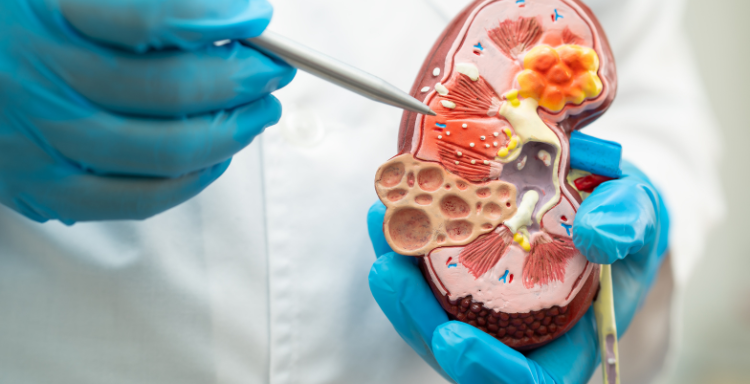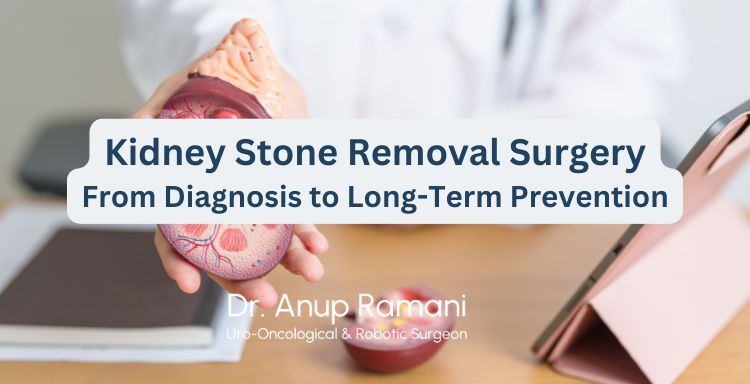Dr Anup Ramani @ Copyright 2024
By Dr. Anup Ramani
Kidney stones are a common urological problem that can cause severe pain and discomfort. If left untreated, they can lead to complications such as infections and kidney damage. Fortunately, advancements in medical technology have made kidney stone removal surgery a safe and effective option. Procedures like URS kidney stone removal and RIRS kidney stone treatment offer minimally invasive solutions, reducing patient discomfort and recovery time.
This article explores the complete process, from diagnosis to long-term prevention, ensuring a comprehensive understanding of kidney stone management.
Diagnosing Kidney Stones
Before opting for surgery for kidney stones, a proper diagnosis is crucial. Common diagnostic methods include:
- Ultrasound & CT Scan – These imaging tests help locate the stones and determine their size.
- Urine Analysis – Detects signs of infection and evaluates the mineral composition.
- Blood Tests – Identifies potential causes, such as high calcium or uric acid levels.
Early detection allows doctors to choose the most suitable treatment, whether it’s medication, lifestyle changes or kidney stone extraction surgery.

Types of Kidney Stone Removal Surgery
There are multiple surgical options for removing a kidney stone surgery, depending on the stone’s size and location:
1. Ureteroscopy Surgery (URS) with Laser Lithotripsy
- A commonly performed procedure that does not require incisions.
- A thin scope is inserted through the urethra to reach the kidney stone.
- The stone is broken down using a laser and removed.
- Ideal for medium-sized stones in the ureter or kidney.
2. Retrograde Intrarenal Surgery (RIRS)
- A more advanced method where a flexible scope enters the kidney through the urethra.
- Laser energy is used to fragment the stone, allowing natural passage through urine.
- Often preferred for larger stones or when other treatments fail.
Procedure Duration and Recovery Timeline
Kidney Stone Operation Time
- URS kidney stone removal and RIRS kidney stone treatment typically take 40-50 minutes. Sometimes, it may take longer, depending on stone size and complexity.
- Patients receive spinal or general anesthesia to ensure a painless procedure.
Kidney Stone Procedure Recovery Time
- Most patients are mobile within a few hours after surgery.
- A catheter is placed to drain urine post-surgery.
- Patients can usually go home the next day after catheter removal.
- Laser surgery for kidney stones recovery time is usually a week, while strenuous activities should be avoided for a month.
For those seeking kidney stone treatment in Mumbai, consulting Dr. Anup Ramani to determine the best approach based on medical necessity.
Long-Term Prevention of Kidney Stones Removal
After a successful kidney stone removal process, preventing recurrence is essential. Steps to reduce the risk include:
1. Hydration is Key
- Drink at least 2-3 liters of water daily to flush out toxins.
- Hydration prevents mineral buildup, reducing stone formation.
2. Dietary Adjustments
- Reduce salt and animal protein intake.
- Limit foods high in oxalates (e.g., spinach, nuts, chocolate).
- Increase consumption of citrus fruits to prevent calcium stone formation.
3. Regular Medical Check-Ups
- Routine urine and blood tests help monitor kidney health.
- Doctors may prescribe medication to prevent further stone formation.
Post-Surgical Care: Ensuring a Smooth Recovery
Following kidney stone removal by surgery, proper care is essential for faster healing and preventing complications.
1. Managing Post-Surgical Pain and Discomfort
- Patients may experience mild discomfort, which can be managed with pain relievers.
- Drinking plenty of fluids helps flush out stone fragments and prevent further formation.
2. Following Dietary Recommendations
- Avoid high-oxalate foods like spinach, nuts, and chocolate.
- Reduce salt intake to lower the risk of calcium-based stones.
- Increase citrus fruit consumption (lemons, oranges) to prevent calcium stone formation.
Conclusion
Undergoing kidney stone removal by surgery is a life-changing procedure that relieves pain and prevents complications. With minimally invasive options like RIRS surgery for kidney stone, patients can recover quickly and return to their daily routines. However, prevention is equally important – staying hydrated, following a balanced diet and regular health check-ups can significantly reduce the risk of recurrence. If you experience symptoms, seek medical advice to Dr. Anup Ramani promptly to ensure a smooth treatment journey.
FAQs About Kidney Stone Removal Surgery
How long does it take to recover from kidney stone removal surgery?
The kidney stone procedure recovery time varies. Most patients can resume normal activities within a week, but heavy exercise should be avoided for a month.
Is kidney stone surgery painful?
No, the procedure is performed under spinal or general anesthesia, ensuring a painless experience. Minor discomfort may be present during recovery.
What is the success rate of RIRS kidney stone treatment?
The success rate of RIRS kidney stone surgery is over 90%, making it a highly effective option.
Can kidney stones come back after surgery?
Yes, kidney stones can recur if preventive measures are not followed. Proper hydration, diet changes and medical check-ups help prevent recurrence.
Read More Articles on Kidney Stone Removal Surgery
About Author

Uro-Oncological & Robotic Surgeon
Dr. Anup Ramani is a robotic uro-oncological surgeon and an internationally recognized expert in robotic surgery for prostate, kidney and urinary bladder cancers. With more than two decades of robotic experience and 2,000+ robotic procedures, he brings unmatched precision and outcomes to complex uro-oncology cases. He is widely published in his field and is known for a personal, transparent approach-often spending over an hour in initial consultations to educate patients on its disease, surgery and recovery. His expertise spans prostate cancer treatment, kidney and bladder cancer surgery, adrenal gland surgery, kidney stone treatment, penile cancer surgery and enlarged prostate management. Dr. Ramani advocates the advantages of robotic surgery-magnified 3D vision, tremor-filtered precision, minimal scarring, lower blood loss and faster recovery-helping patients return to life sooner.
Table of Contents
Recent Blogs
Best Uro-Oncological surgeon
Specialist in India for Robotic Surgery
MCh, DNB, MS, DNB
Dr. Anup Ramani
CONTACT
Uro-Oncologist in India,
Best Robotic Surgeon for Uro Oncology Surgery
1407, One Lodha Place Next to World Towers Senapati Bapat Marg, Worli, Mumbai. 400013.
Dr Anup Ramani @ Copyright 2024 – Website Maintenance, SEO & GEO by Opal Infotech
- Partial penectomy is done in cases where glans and distal penis is involved with carcinoma.
- Partial penectomy is a type of organ-preserving surgery. Preservation of sexual and micturational function depends on the surgical dissection and reconstruction of residual urethra.
- Patients who develop stones in the kidney or ureter, often experience severe pain.
- This condition usually needs a procedure to remove the kidney stones.
- This procedure is called ureteroscopy and is performed very commonly.
- It does not require any cuts and hence it is painless.
- The procedure is performed with an endoscope inserted through the penis under spinal anesthesia.
- The scope is inserted through the penis into the kidney and stones are dissolved with a laser.
- The procedure takes about 40-50 minutes.
- A catheter (urine pipe) is kept after the procedure to drain the bladder. A stent is kept in the kidney at the same time.
- Patient is mobile and walking in the room the same evening.
- Hospital stay is one night and patient is discharged the next day after removal of the catheter.
- Patient has to come back after six weeks to remove the stent in the kidney.
- Patients can resume office a week after surgery and heavy activities like running, weight lifting, a month after the procedure.
- We offer fixed packages for this procedure which can be obtained by calling our helpline +91 9967666060.
- Men with an enlarged prostate, which is a normal ageing changes, often experiencing difficulty passing urine. This condition usually needs a procedure to trim the prostate and relieve the blockage.
- This procedure is called TURP and is performed very commonly.
- It does not require any cuts and hence it is painless.
- The procedure is performed with an endoscope inserted through the penis under spinal anaesthesia.
- The overgrown prostate is dissolved with a laser bloodlessly.
- The procedure takes about 40 minutes.
- A catheter (urine pipe) is kept after the procedure to drain the bladder.
- Patient is mobile and walking in the room the same evening.
- Hospital stay is two nights and patient is discharged with the catheter, which is removed after 4 days.
- Patients can resume office a week after surgery and heavy activities like running, weight lifting, a month after the procedure.
- We offer fixed packages for this procedure which can be obtained by calling our helpline +91 9967666060.
-
Robotic adrenalectomy is a sophisticated, complex surgery and it is very important that an experienced surgeon performs this surgery to avoid major complications.
-
Once the anesthesia is done, and patient positioned, three micro cuts (3mm each) are made in the patient’s abdomen.
-
The arms of the Da Vinci robot are connected to the cuts via ports (tubes).
-
Dr. Ramani then sits in the controlling console to perform the surgery.
-
On an average, a robotic adrenalectomy takes one hour.
-
The surgery is almost completely bloodless and there has never been any need to transfuse blood after surgery.
-
A urine catheter and bag to drain the bladder is inserted during surgery.
-
A tiny drain pipe may be inserted in the surgical side of the abdomen, connected to a bag.
-
Patient is kept nil-by-mouth the day of the surgery, with IV fluids. Sips of water are started the next day and solid food by day three.
-
The drain pipe, if kept, is removed in the room on day 2 after surgery.
-
The catheter is removed on day two after surgery.
-
Total hospital stay for robotic adrenalectomy is 4 nights (including night before surgery).
-
Post discharge, a doctor from the surgical team visits the patient at home/ hotel room once every day.
On the day of discharge, patient is totally self-sufficient. They are able to walk freely without any pain, dress themselves, shower, toilet and they do not need to hire any nurse or help at home. Almost all patients are back to work within 2 weeks of surgery.
Heavy activities like running, weight lifting can be resumed after a month
Follow up after an adrenalectomy is in the form of CT scans, once a year for 5 years.
Local patients usually meet Dr. Ramani after two weeks to discuss report.Outstation patients are counselled on a phone consultation.
- Dr. Ramani is one of the very few surgeons in India who has the expertise to perform a robotic surgery for bladder cancer, which includes removing the urinary bladder and reconstructing a new bladder robotically.
- Robotic radical cystectomy is an extremely sophisticated, complex surgery and it is very important that an experienced surgeon performs this surgery to avoid major complications.
- Once the anaesthesia is done, and patient positioned, six micro cuts (3mm each) are made in the patient’s abdomen.
- The arms of the Da Vinci robot are connected to the cuts via ports (tubes).
- Dr. Ramani then sits in the controlling console to perform the surgery.
- On an average, a robotic radical cystectomy with an ileal conduit takes 3-4 hours.
- The surgery is almost completely bloodless and there has never been any need to transfuse blood after surgery.
- A urine catheter and bag to drain the new bladder is inserted during surgery.
- Two tiny drain pipe in inserted in the surgical side of the abdomen, connected to a bag.
- Patient is kept nil-by-mouth for 4 days after surgery with IV supplementation of patient’s daily requirements of calories, fats, carbohydrates, proteins and electrolytes.
- The drain pipes are removed in the room on day 3-5 after surgery.
- Total hospital stay for radical cystectomy is 8 nights (including night before surgery).
- Post discharge, a doctor from the surgical team visits the patient at home/ hotel room once every day.
- On the day of discharge, patient is totally self-sufficient. They are able to walk freely without any pain, dress themselves, shower, toilet and they do not need to hire any nurse or help at home.
- Almost all patients are back to work within 6 weeks of surgery. Heavy activities like running, weight lifting can be resumed after two months.
Follow up after a radical a cystectomy is in the form of CT scans, once a year for 5 years.
Histopathology report: Local patients usually meet Dr. Ramani after two weeks to discuss report.
Outstation patients are counselled on a phone consult. Depending on the report, patient may or may not need chemotherapy after surgery.
If chemo is needed, patients may choose to get it done with a medical oncologist of their choice or avail the services of one of the four medical oncologists on our team.
- Robotic partial nephrectomy is a sophisticated, complex surgery and it is very important that an experienced surgeon performs this surgery to avoid major complications. Robotic radical (total) nephrectomy is
- relatively easier but still requires significant experience to consistently deliver results.
- Once the anaesthesia is done, and patient positioned, five micro cuts (3mm each) are made in the patient’s abdomen.
- The arms of the Da Vinci robot are connected to the cuts via ports (tubes).
- Dr. Ramani then sits in the controlling console to perform the surgery.
- On an average, a robotic radical nephrectomy takes one hour and a robotic partial nephrectomy takes about an hour and half.
- The surgery is almost completely bloodless and there has never been any need to transfuse blood after surgery.
- A urine catheter and bag to drain the bladder is inserted during surgery.
- A tiny drain pipe in inserted in the surgical side of the abdomen, connected to a bag.
- Patient is kept nil-by-mouth the day of the surgery, with IV fluids. Sips of water are started the next day and solid food by day three.
- The drain pipe is removed in the room on day 3 after surgery. The catheter is removed on day two after surgery.
- Total hospital stay for radical/partial nephrectomy is 4 nights (including night before surgery).
- Post discharge, a doctor from the surgical team visits the patient at home/ hotel room once every day.
- On the day of discharge, patient is totally self- sufficient.
- They are able to walk freely without any pain, dress themselves, shower, toilet and they do not need to hire any nurse or help at home.
- Almost all patients are back to work within 2-3 weeks of surgery.
- Heavy activities like running, weight lifting can be resumed after a month.
- Follow up after a radical/partial Nephrectomy is in the form of CT scans, once a year for 5 years.
- Local patients usually meet Dr. Ramani after two weeks to discuss report.
- Outstation patients are counselled on a phone consultation.







